《诊断学》课程教学实验指导
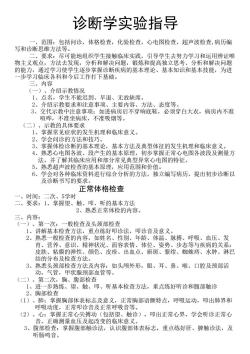
诊断学实验指导 一、范围:包括问诊,体格检查,化验检查,心电图检查,超声波检查,病历编 写和诊断思维方法等: 要求: 尽可能地组织学生接触临床实践, 引导学生去努力学习和运用辨证唯 物主义观点,方法去发现,分析和解决问题,锻炼和提高独立思考、分析和解决问题 的能力,通过学习使学生逐步掌握诊断疾病的基本理论、基本知识和基本技能,为进 步学习临床各科和今后工作打下基础。 二、内谷容 (一)、介绍示教情况 1、点名,学生不能迟到、早退、无故缺席 2、介绍示教要求和注意事项、主要内容、方法、态度等。 3、交代示教中注意事项:如进病房后不穿响底鞋,必须穿白大衣,病房内不准 喧哗,不准坐病床,不准吸烟等。 (二)、示教的具体要求 1、掌握常见症状的发生机理和临床意义。 2、学会问诊的方法和技巧。 3、 掌握体检诊断的基本理论,基本方法及典型体征的发生机理和临床意义。 4、熟悉心电图各波、段产生的基本原理,初步掌握正常心电图各波段及测量方 法,并了解其临床应用和部分常见典型异常心电图的特征。 5、 熟悉超声波检查的基本原理, 应用范围和价值。 6、学会对各种临床资料进行综合分析的方法,独立编写病历,提出初步诊断以 及诊断书写的要求, 正常体格检查 一、时间: 一次、5学时 二、要求:1、掌握望、触、叩、听的基本方法 2、熟悉正常体检的内容。 三、内容 (一)、 第一次 一般检查及头颈部检查 1、讲解基本检查方法,重点练好叩诊法,叩诊音及意义。 2、熟悉一般检查的内容,如姓名、性别、年龄、体温、脉搏、呼吸、血压、发 育、营养 意识、 精神状况、面容表情、体位、姿势、步态等与疾病的关系 皮肤、粘膜的弹性、颜色、皮疹、出血点、瘀斑、紫绀、蜘蛛痔、水肿、淋巴 结的分布及检查方法。 3、熟悉头颈部检查方法及内容:如头颅外形,眼、耳、鼻、喉、口腔及颈部活 动,气管,甲状腺颈部血管等。 (二)、第二次,胸、腹部检查 1、进一步熟练、望、触、叩、听基本检查方法,重点练好听诊和腹部触诊 2、胸部检查 (1)、肺:掌握胸部体表标志及意义,正常胸部语颤特点,呼吸运动,叩出肺界和 呼吸动度,正常叩诊音及正常呼吸音等。 (2)、 心:掌握正常心尖搏动(包括望、触诊),叩出正常心界,学会听诊正常心 音,正确测量血压及起改变的临床意义。 3、腹部检查:掌握腹部触诊法,认识腹部体表标志,重点练好肝、脾触诊法,及 听肠鸣音
诊断学实验指导 一、范围:包括问诊,体格检查,化验检查,心电图检查,超声波检查,病历编 写和诊断思维方法等。 二、要求:尽可能地组织学生接触临床实践,引导学生去努力学习和运用辨证唯 物主义观点,方法去发现,分析和解决问题,锻炼和提高独立思考、分析和解决问题 的能力,通过学习使学生逐步掌握诊断疾病的基本理论、基本知识和基本技能,为进 一步学习临床各科和今后工作打下基础。 三、内容 (一)、介绍示教情况 1、点名,学生不能迟到、早退、无故缺席。 2、介绍示教要求和注意事项、主要内容、方法、态度等。 3、交代示教中注意事项:如进病房后不穿响底鞋,必须穿白大衣,病房内不准 喧哗,不准坐病床,不准吸烟等。 (二)、示教的具体要求 1、掌握常见症状的发生机理和临床意义。 2、学会问诊的方法和技巧。 3、掌握体检诊断的基本理论,基本方法及典型体征的发生机理和临床意义。 4、熟悉心电图各波、段产生的基本原理,初步掌握正常心电图各波段及测量方 法,并了解其临床应用和部分常见典型异常心电图的特征。 5、熟悉超声波检查的基本原理,应用范围和价值。 6、学会对各种临床资料进行综合分析的方法,独立编写病历,提出初步诊断以 及诊断书写的要求。 正常体格检查 一、时间:二次、5学时 二、要求:1、掌握望、触、叩、听的基本方法 2、熟悉正常体检的内容。 三、内容: (一)、第一次:一般检查及头颈部检查 1、讲解基本检查方法,重点练好叩诊法,叩诊音及意义。 2、熟悉一般检查的内容,如姓名、性别、年龄、体温、脉搏、呼吸、血压、发 育、营养、意识、精神状况、面容表情、体位、姿势、步态等与疾病的关系: 皮肤、粘膜的弹性、颜色、皮疹、出血点、瘀斑、紫绀、蜘蛛痔、水肿、淋巴 结的分布及检查方法。 3、熟悉头颈部检查方法及内容:如头颅外形,眼、耳、鼻、喉、口腔及颈部活 动,气管,甲状腺颈部血管等。 (二)、第二次,胸、腹部检查 1、进一步熟练、望、触、叩、听基本检查方法,重点练好听诊和腹部触诊 2、胸部检查 (1)、肺:掌握胸部体表标志及意义,正常胸部语颤特点,呼吸运动,叩出肺界和 呼吸动度,正常叩诊音及正常呼吸音等。 (2)、心:掌握正常心尖搏动(包括望、触诊),叩出正常心界,学会听诊正常心 音,正确测量血压及起改变的临床意义。 3、腹部检查:掌握腹部触诊法,认识腹部体表标志,重点练好肝、脾触诊法,及 听肠鸣音
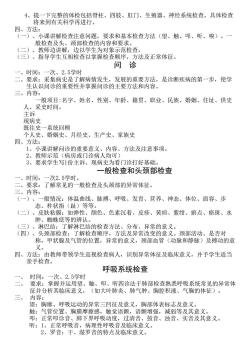
4、提一下完整的体检包括脊柱、四肢、肛门、生殖器、神经系统检查,具体检查 将来到有关科学再进行 四、方法: (一)、小课讲解检查注意问题,要求和基本检查方法(望、触、叩、听、嗅)。一 般检查及头、颈部检查的内容和要求 (二)、教师边讲解,边以学生为对象示范检查 (三)、指导学生互相检查以掌握检查顺序,方法及正常体征。 问诊 一、时间:一次、2.5学时 二、要求:采集病史是了解病情发生,发展的重要方法,是诊断疾病的第一步,使学 生认识问诊的重要性并掌握问诊的主要方法和内容。 三、内容: 一般项目:名字、姓名、性别、年龄、籍贯、职业、民族、婚姻、住址、供史 人、采史时间。 注诉 现病史 既往史 一系统回顾 个人史、婚姻史、月经史、生产史、家族史 四、方法: 1、小课讲解问诊的重要意义、内容、方法及注意事项。 2、教师示范(病房或门诊病人均可) 3、要求学生写1份主诉、现病史为看门诊打好基础。 一般检查和头颈部检查 一、时间: 一次2.5学时」 二、要求:了解常见的一般检查及头颈部的异常体征。 三、内容: (一) 一般情况:体温曲线、脉搏、呼吸、发育、营养、神态、体位、面容、步 态、 杵状指(趾)等等。 (二)、皮肤粘膜:如弹性、颜色、色素沉着、皮疹、黄疸、紫绀、瘀点、瘀斑、水 肿、蜘蛛痣等的辨认。 (三)、 淋结 了解淋巴结的检查方法、分布、异常的意义。 (四)、头颈部检查:了解检查顺序,方法及异常改变的意义。颈部活动、是否对 称,甲状腺及气管的位置,异常的意义,颈部血管(动脉和静脉)及搏动的意 义 四、方法:由教师带领学生巡视检查病人,识别异常体征及临床意义,并予学生适当 亲手检查。 呼吸系统检查 一、 时时间:一次、2.5学计 、 要求:掌握并运用望、触、叩、听四诊法于肺部检查熟悉呼吸系统常见的异常体 征并分析其临床意义,(如大叶肺炎、肺气肿、胸腔积液、气胸的体征)。 一、 内容: 望:胸席、呼吸运动的异常三凹征及意义,胸部体表标志及意义。 触:气管位置、胸膜摩擦感,触觉语颤,语颤增强,减弱等及其意义。 叩:正常叩诊音、肺下界呼吸动度,过清音、鼓音、浊音、实音及其意义
4、提一下完整的体检包括脊柱、四肢、肛门、生殖器、神经系统检查,具体检查 将来到有关科学再进行。 四、方法: (一)、小课讲解检查注意问题,要求和基本检查方法(望、触、叩、听、嗅)。一 般检查及头、颈部检查的内容和要求。 (二)、教师边讲解,边以学生为对象示范检查。 (三)、指导学生互相检查以掌握检查顺序,方法及正常体征。 问 诊 一、时间:一次、2.5学时 二、要求:采集病史是了解病情发生,发展的重要方法,是诊断疾病的第一步,使学 生认识问诊的重要性并掌握问诊的主要方法和内容。 三、内容: 一般项目:名字、姓名、性别、年龄、籍贯、职业、民族、婚姻、住址、供史 人、采史时间。 主诉 现病史 既往史一系统回顾 个人史、婚姻史、月经史、生产史、家族史 四、方法: 1、小课讲解问诊的重要意义、内容、方法及注意事项。 2、教师示范(病房或门诊病人均可) 3、要求学生写1份主诉、现病史为看门诊打好基础。 一般检查和头颈部检查 一、时间:一次2.5学时。 二、要求:了解常见的一般检查及头颈部的异常体征。 三、内容: (一)、一般情况:体温曲线、脉搏、呼吸、发育、营养、神态、体位、面容、步 态、杵状指(趾)等等。 (二)、皮肤粘膜:如弹性、颜色、色素沉着、皮疹、黄疸、紫绀、瘀点、瘀斑、水 肿、蜘蛛痣等的辨认。 (三)、淋巴结:了解淋巴结的检查方法、分布、异常的意义。 (四)、头颈部检查:了解检查顺序,方法及异常改变的意义。颈部活动、是否对 称,甲状腺及气管的位置,异常的意义,颈部血管(动脉和静脉)及搏动的意 义。 四、方法:由教师带领学生巡视检查病人,识别异常体征及临床意义,并予学生适当 亲手检查。 呼吸系统检查 一、 时间:一次、2.5学时 二、 要求:掌握并运用望、触、叩、听四诊法于肺部检查熟悉呼吸系统常见的异常体 征并分析其临床意义,(如大叶肺炎、肺气肿、胸腔积液、气胸的体征)。 三、 内容: 望:胸廓、呼吸运动的异常三凹征及意义,胸部体表标志及意义。 触:气管位置、胸膜摩擦感,触觉语颤,语颤增强,减弱等及其意义。 叩:正常叩诊音、肺下界呼吸动度,过清音、鼓音、浊音、实音及其意义。 听:1、正常呼吸音,病理性呼吸音及临床意义。 2、罗音:干、湿罗音的特点及临床意义
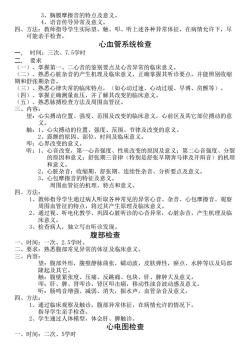
3、胸膜摩擦音的特点及意义。 4、语音传导异常及意义。 四、方法:教师指导学生实际望、触、叩、听上述各种异常体征,在病情允许下,尽 可能亲手检香。 心血管系统检查 、 时间:三次、7.5学时 要求 (一)、掌握第一、 二心音的鉴别要点及心音异常的临床意义 、熟悉心脏杂音的产生机理及临床意义,正确掌握其听诊要点,并能辨别收缩 期和舒张期杂音。 (三)、熟悉心律失常的临床特点, (如心动过速、心动过缓、早博、房颤等)。 (四)、掌握正确测量血压,并了解其改变的临床意义。 (五)、熟悉脉搏检查方法及周围血管征。 三、内容: 望:心尖搏动位置、强度、范围及改变的临床意义,心前区及其它部位搏动的意 义。 触:1、心尖搏动的位置、强度、范围、节律及改变的意义。 2、震颤的原因、部位、时间及临床意义。 叩:心界改变的意义。 听:1、心音改变,第一心音强度、性质改变的原因及意义:第二心音强度、分裂 的原因和意义;舒张期三音律(特别是舒张早期奔马律及开辩音)的机理 和总义。 2、心脏杂音:收缩期、舒张期、连续性杂音、分析要点及意义。 3、心包摩擦音的特征及意义。 周围血管征的机理、特点和意义。 四、方法: 1、教师指导学生通过病人听取各种常见的异常心音、杂音、心包摩擦音、观察 周围血管征的特点,将过其产生 原理及临床意义 2、通过视、听电化教学、巩固心脏听诊的心音异常,心脏杂音,产生机理及临 来意义 3、检查病人,独立写出听诊发现。 腹部检查 一、时间: 次、2.5学时。 二、要求:熟悉腹部常见异常的体征及临床意义。 三、内容 望:腹部外形,腹壁静脉曲张,蠕动波,皮肤弹性,瘀点、水肿等以及局部 降记及其它。 触:腹壁紧张度、压痛、反跳痛、包块、肝、脾肿大及意义。 叩:肝、脾 肾叩诊 肾区叩击痛,移动性浊音波动感及意义。 听:肠鸣音增强、减弱、消失,振水声,血管杂音及意义。 四、方法: 1、通过临床观察及触诊,腹部异常体征,在病情允许的情况下, 指导学生亲手检查。 2、学生通过人体模型,体会肝、脾触诊。 心电图检查 一、时间:二次、5学时
3、胸膜摩擦音的特点及意义。 4、语音传导异常及意义。 四、方法:教师指导学生实际望、触、叩、听上述各种异常体征,在病情允许下,尽 可能亲手检查。 心血管系统检查 一、 时间:三次、7.5学时 二、 要求 (一)、掌握第一、二心音的鉴别要点及心音异常的临床意义。 (二)、熟悉心脏杂音的产生机理及临床意义,正确掌握其听诊要点,并能辨别收缩 期和舒张期杂音。 (三)、熟悉心律失常的临床特点,(如心动过速、心动过缓、早博、房颤等)。 (四)、掌握正确测量血压,并了解其改变的临床意义。 (五)、熟悉脉搏检查方法及周围血管征。 三、内容: 望:心尖搏动位置、强度、范围及改变的临床意义,心前区及其它部位搏动的意 义。 触:1、心尖搏动的位置、强度、范围、节律及改变的意义。 2、震颤的原因、部位、时间及临床意义。 叩:心界改变的意义。 听:1、心音改变,第一心音强度、性质改变的原因及意义;第二心音强度、分裂 的原因和意义;舒张期三音律(特别是舒张早期奔马律及开辩音)的机理 和意义。 2、心脏杂音:收缩期、舒张期、连续性杂音、分析要点及意义。 3、心包摩擦音的特征及意义。 周围血管征的机理、特点和意义。 四、方法: 1、教师指导学生通过病人听取各种常见的异常心音、杂音、心包摩擦音、观察 周围血管征的特点,将过其产生原理及临床意义。 2、通过视、听电化教学、巩固心脏听诊的心音异常,心脏杂音,产生机理及临 床意义。 3、检查病人,独立写出听诊发现。 腹部检查 一、时间:一次、2.5学时。 二、要求:熟悉腹部常见异常的体征及临床意义。 三、内容: 望:腹部外形,腹壁静脉曲张,蠕动波,皮肤弹性,瘀点、水肿等以及局部 隆起及其它。 触:腹壁紧张度、压痛、反跳痛、包块、肝、脾肿大及意义。 叩:肝、脾、肾叩诊,肾区叩击痛,移动性浊音波动感及意义。 听:肠鸣音增强、减弱、消失,振水声,血管杂音及意义。 四、方法: 1、通过临床观察及触诊,腹部异常体征,在病情允许的情况下, 指导学生亲手检查。 2、学生通过人体模型,体会肝、脾触诊。 心电图检查 一、时间:二次、5学时
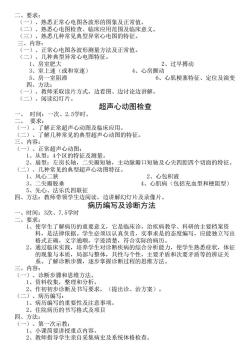
二、要求: (一)、熟悉正常心电图各波形的图象及正常值 (二)、熟悉心电图检查、临床应用范围及临床意义。 (三)、熟悉几种常见典型异常心电图的特征。 三、内容: (一)、正常心电图各波形测量方法及正常值。 (二)、几种典型异常心电图特征。 1、房室肥大 、过早搏动 3、室上速(或和室速) 4、心房颤动 5、房一室阻滞 6、心肌梗塞特征、定位及演变 四、方法: )、教师采取读片方式,边看图、边讨论边讲解。 (二)、悦卖么片。 超声心动图检查 时间:一次、2.5学时。 一 要求: (一)、了解正常超声心动图及临床应用。 (二)、了解几种常见的典型超声心动图的特征。 三、内容: (一)、 正常超声心动图: 1、从型:4个区的特征及测量。 2、扇型:左房长轴,二尖瓣短轴,主动脉瓣口短轴及心尖四腔四个切面的特征。 (二)、 几种常见的典型超声心动图特征。 1、侠 2、心包积液 3、二尖瓣脱垂 4、心肌病(包括充血型和梗阻型) 5、先心、法乐氏四联征 四、方法:教师带领学生边阅读,边讲解幻灯片及录像片。 病历编写及诊断方法 一、时间:3次、7.5学时 二、要求: 1、使学生了解病历的重要意义, 它是临床诊,治疾病教学、科研的主要档案资 料,是法律依据。学生必须以认真负责,实事求是的态度编写,应能独立写出 格式正确,文字通顺,字迹清楚,符合实际的病历。 2、通过临床实践,培养学生对诊断疾病的综合分析能力,使学生熟悉症状,体征 的现象与本质,局部与整体,共性与个性,主要矛盾和次要矛盾等的辨证关 系。了解诊断步骤,逐步掌握诊断过程的思维方法。 三、内容: (一)、诊断步骤和思维方法。 1、资料收集,整理和分析。 2、作初初步诊断及书写要求,(提出诊、治方案)。 (二)、病历编写 1、丙历编写的重要性及注意事项。 2、住院病历的书写格式及项目 四、方法: (一)、第一次示教: 1、小课简要讲授重点内容。 2、教师指导学生亲自采集病史及系统体格检查
二、要求: (一)、熟悉正常心电图各波形的图象及正常值。 (二)、熟悉心电图检查、临床应用范围及临床意义。 (三)、熟悉几种常见典型异常心电图的特征。 三、内容: (一)、正常心电图各波形测量方法及正常值。 (二)、几种典型异常心电图特征。 1、房室肥大 2、过早搏动 3、室上速(或和室速) 4、心房颤动 5、房一室阻滞 6、心肌梗塞特征、定位及演变 四、方法: (一)、教师采取读片方式,边看图、边讨论边讲解。 (二)、阅读幻灯片。 超声心动图检查 一、 时间:一次、2.5学时。 二、 要求: (一)、了解正常超声心动图及临床应用。 (二)、了解几种常见的典型超声心动图的特征。 三、内容: (一)、正常超声心动图: 1、从型:4个区的特征及测量。 2、扇型:左房长轴,二尖瓣短轴,主动脉瓣口短轴及心尖四腔四个切面的特征。 (二)、几种常见的典型超声心动图特征。 1、风心二狭 2、心包积液 3、二尖瓣脱垂 4、心肌病(包括充血型和梗阻型) 5、先心、法乐氏四联征 四、方法:教师带领学生边阅读,边讲解幻灯片及录像片。 病历编写及诊断方法 一、时间:3次、7.5学时 二、要求: 1、使学生了解病历的重要意义,它是临床诊,治疾病教学、科研的主要档案资 料,是法律依据。学生必须以认真负责,实事求是的态度编写,应能独立写出 格式正确,文字通顺,字迹清楚,符合实际的病历。 2、通过临床实践,培养学生对诊断疾病的综合分析能力,使学生熟悉症状,体征 的现象与本质,局部与整体,共性与个性,主要矛盾和次要矛盾等的辨证关 系。了解诊断步骤,逐步掌握诊断过程的思维方法。 三、内容: (一)、诊断步骤和思维方法。 1、资料收集,整理和分析。 2、作初初步诊断及书写要求,(提出诊、治方案)。 (二)、病历编写: 1、病历编写的重要性及注意事项。 2、住院病历的书写格式及项目 四、方法: (一)、第一次示教: 1、小课简要讲授重点内容。 2、教师指导学生亲自采集病史及系统体格检查
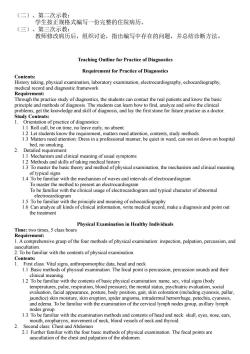
(二)、第二次示教: 学生按正规格式编写一份完整的住院病历 (三)、第三次示教: 教师修改病历后,组织讨论,指出编写中存在的问题,并总结诊断方法。 Teaching Outline for Practice of Diagnostics Requirement for Practice of Diagnostics taking.physical examination,laboratory examination,electrocardiography,echocardiography, medical record and diagnostic framework Requirement: Through the practice study of diagnostics,the students can contact the real patients and know the basic principle and methods of diagnos The students can learn how to find,analyze and solve the clinical roblems.get the knowledge and skill of diagnosis,and lay the first stone for future practice asa doctor. Study Contents .1 Roll call b practice of diagnostic 12 Letstudents ko o absen nethods anner,be quie bed no smoking 2. Detailed requirement 1.1 Mechanism and clinical meaning of usual symptoms 1o m method of physical examination,the mechanism and clinical meaning thth nd ir 人 aaster the ele To be familiar ththe usage of electrocardio am and typical character of abnormal electrocardiogram 1.5 To be familiar with the principle and meaning of echocardiography 1.6 Can analyze all kinds of clinical information.write medical record.make a diagnosis and point out the treatment Physical Examination in Healthy Individuals Time o times,5 class hou m .comprehensive grasp of the four methods of physical examination:inspection,palpation,percussion,and auscultation. 2 To be familiar with the contents of physical examination Contents: First class:Vital signs,anthropomorphic data,head and neck 1.1 ds of physical examination.The focal point is percussion,percussion sounds and their ng h the contents of basic physi name,se vital signs (bod evaluation facial apr nosis.pallar. and edema.To be familiar with the examination of the cervical lymph nodes group,axillary lymph nodes group. 1.3 To be familiar with the examination methods and contents of head and neck:skull,eyes,nose,ears, 2. oropharynx.m ovement of neck.blood vessels of neck and thyroid. 21f me asic meth
(二)、第二次示教: 学生按正规格式编写一份完整的住院病历。 (三)、第三次示教: 教师修改病历后,组织讨论,指出编写中存在的问题,并总结诊断方法。 Teaching Outline for Practice of Diagnostics Requirement for Practice of Diagnostics Contents: History taking, physical examination, laboratory examination, electrocardiography, echocardiography, medical record and diagnostic framework Requirement: Through the practice study of diagnostics, the students can contact the real patients and know the basic principle and methods of diagnosis. The students can learn how to find, analyze and solve the clinical problems, get the knowledge and skill of diagnosis, and lay the first stone for future practice as a doctor. Study Contents: 1. Orientation of practice of diagnostics: 1.1 Roll call, be on time, no leave early, no absent 1.2 Let students know the requirement, matters need attention, contents, study methods. 1.3 Matters need attention: Dress in a professional manner, be quiet in ward, can not sit down on hospital bed, no smoking. 2. Detailed requirement: 1.1 Mechanism and clinical meaning of usual symptoms 1.2 Methods and skills of taking medical history 1.3 To master the basic theory and method of physical examination, the mechanism and clinical meaning of typical signs 1.4 To be familiar with the mechanism of waves and intervals of electrocardiogram To master the method to present an electrocardiogram To be familiar with the clinical usage of electrocardiogram and typical character of abnormal electrocardiogram 1.5 To be familiar with the principle and meaning of echocardiography 1.6 Can analyze all kinds of clinical information, write medical record, make a diagnosis and point out the treatment Physical Examination in Healthy Individuals Time: two times, 5 class hours Requirement: 1. A comprehensive grasp of the four methods of physical examination: inspection, palpation, percussion, and auscultation. 2. To be familiar with the contents of physical examination. Contents: 1. First class: Vital signs, anthropomorphic data, head and neck 1.1 Basic methods of physical examination. The focal point is percussion, percussion sounds and their clinical meaning. 1.2 To be familiar with the contents of basic physical examination: name, sex, vital signs (body temperatures, pulse, respiration, blood pressure), the mental status, psychiatric evaluation, social evaluation, facial appearance, posture, body position, gait, skin coloration (including cyanosis, pallar, jaundice) skin moisture, skin eruption, spider angioma, intradermal hemorrhage, petechia, cyanosis, and edema. To be familiar with the examination of the cervical lymph nodes group, axillary lymph nodes group. 1.3 To be familiar with the examination methods and contents of head and neck: skull, eyes, nose, ears, mouth, oropharynx, movement of neck, blood vessels of neck and thyroid. 2. Second class: Chest and Abdomen 2.1 Further familiar with the four basic methods of physical examination. The focal points are auscultation of the chest and palpation of the abdomen
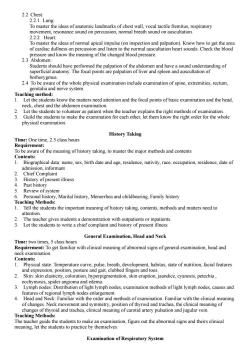
2.2 Chest 2.2.1 Lung: 29 Hea e ideas of normal anical in ulse (on ins pection and palpation).Know how to get the area of cardiac dullness on p n and listen to the n scultation heart sounds.Check the blood ssure and know the meaning of the changed blood pressure. 2.3A60e4 Students should have performed the palpation of the abdomen and have a sound understanding of superficial anatomy.The focal points are palpation of liver and spleen and auscultation of borhorygmus 2.4 To be awar ds to uouu uouguIExa IeaisAud alous am Io Teachin Let the studen nts know the matters need attention and the focal points of basic examination and the head, neck.chest and the abdomen examination 2. Let the students to volunteer as patient when the teacher explains the right methods of examination. 3. Guild the students to make the examination for each other,let them know the right order for the whole physical examination. History Taking th meanins of history taking.to master the maior metodsnd Contents: 1 Biographical data:name,sex,birth date and age,residence,nativity,race,occupation,residence,date of admission,informant Chief Complaint syste y,Marital history,Menorrhea and childbearing.Family history Teaching Metho Tell the students the important meaning of history taking,contents,methods and matters need to attention The teacher gives students a demonstration with outpatients or inpatients 3 Let the students to write a chief complaint and history of present illness General Examination,Head and Necl two tim ili vith clinical get ia meaning of abnormal signs of general examination,head and an Contents: 1.Physical state:Temperature curve,pulse,breath,development,habitus,state of nutrition,facial features and expression,position,posture and gait,clubbed fingers and toes. 2. Skin:skin elasticity,coloration,hyperpigmentation,skin eruption,jaundice,cyanosis,petechia ecchymosis,spider angioma an dema 3. Lymph nodes ribution c light lymph nodes.examination methods of light lymph nodes,causes and teaare2dN ymph n Familiar with the clinical meaning of changes. and g roid and trachea the cli ical meaning of 、hange Teaching Methods: The teacher guide the students to make an examination,figure out the abnormal signs and theirs clinical meaning.let the students to practice by themselves. Examination of Respiratory System
2.2 Chest: 2.2.1 Lung: To master the ideas of anatomic landmarks of chest wall, vocal tactile fremitus, respiratory movement, resonance sound on percussion, normal breath sound on auscultation. 2.2.2 Heart: To master the ideas of normal apical impulse (on inspection and palpation). Know how to get the area of cardiac dullness on percussion and listen to the normal auscultation heart sounds. Check the blood pressure and know the meaning of the changed blood pressure. 2.3 Abdomen: Students should have performed the palpation of the abdomen and have a sound understanding of superficial anatomy. The focal points are palpation of liver and spleen and auscultation of borhorygmus. 2.4 To be aware of the whole physical examination include examination of spine, extremities, rectum, genitalia and nerve system. Teaching method: 1. Let the students know the matters need attention and the focal points of basic examination and the head, neck, chest and the abdomen examination. 2. Let the students to volunteer as patient when the teacher explains the right methods of examination. 3. Guild the students to make the examination for each other, let them know the right order for the whole physical examination. History Taking Time: One time, 2.5 class hours Requirement: To be aware of the meaning of history taking, to master the major methods and contents Contents: 1. Biographical data: name, sex, birth date and age, residence, nativity, race, occupation, residence, date of admission, informant 2. Chief Complaint 3. History of present illness 4. Past history 5. Review of system 6. Personal history, Marital history, Menorrhea and childbearing, Family history Teaching Methods: 1. Tell the students the important meaning of history taking, contents, methods and matters need to attention. 2. The teacher gives students a demonstration with outpatients or inpatients. 3. Let the students to write a chief complaint and history of present illness General Examination, Head and Neck Time: two times, 5 class hours Requirement: To get familiar with clinical meaning of abnormal signs of general examination, head and neck examination. Contents: 1. Physical state: Temperature curve, pulse, breath, development, habitus, state of nutrition, facial features and expression, position, posture and gait, clubbed fingers and toes. 2. Skin: skin elasticity, coloration, hyperpigmentation, skin eruption, jaundice, cyanosis, petechia , ecchymosis, spider angioma and edema. 3. Lymph nodes: Distribution of light lymph nodes, examination methods of light lymph nodes, causes and features of regional lymph nodes enlargement. 4. Head and Neck: Familiar with the order and methods of examination. Familiar with the clinical meaning of changes. Neck movement and symmetry, position of thyroid and trachea, the clinical meaning of changes of thyroid and trachea, clinical meaning of carotid artery pulsation and jugular vein. Teaching Methods: The teacher guide the students to make an examination, figure out the abnormal signs and theirs clinical meaning, let the students to practice by themselves. Examination of Respiratory System
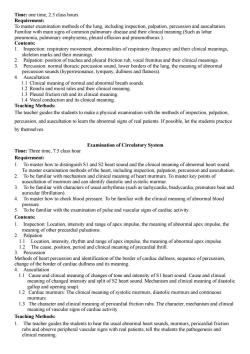
Time:one time,2.5 class hours Requirement: un nngpn.prcon n signs of dis ral effus Contents: p and pneum othorax pection:respiratory movement,abnormalities of respiratory frequency and their clinical meanings. skeleton marks and their meanings Palpation:position of trachea and pleural friction rub,vocal fremitus and their clinical meanings. 3 Percussion:normal thoracic percussion sound,lower borders of the lung,the meaning of abnormal percussion sounds(hyperresonance,tympany,dullness and flatness). 12R meaning of norma and ab nal breath sound 、li 1.3 Pleural friction rub and its cli ical n 14 Vocal conduction and its clinical meaning. Teaching Methods: The teacher guides the students to make a physical examination with the methods of inspection,palpation, percussion,and auscultation to learn the abnormal signs of real patients.If possible.let the students practice by themselves. Examination of Circulatory System Time:Three time,7.5 class hour Requirement: To master how to distingui 0 on,percus auscultation 2. lo be r vith mecha clinical ning of he 3. To be famil ith characters Tpbenlaiaw al ar ardia.bradycardia,premature beat and 4.To master how to check blood pressure.To be familiar with the clinical meaning of abnormal blood pressure. 5. To be familiar with the examination of pulse and vascular signs of cardiac activity Contents: 1. Inspection ocation,in and range of apex impulse,the meaning of abnormal apex impulse,the tio of other precardial pulsations 11 location intensity.rhythm and ra of a ex impulse the meaning of abnormal apex impulse 12 The cause,position, of precardial thril 3. Percussion Methods of heart percussion and identification of the border of cardiac dullness,sequence of percussion, change of the border of cardiac dullness and its meaning. 1.1 Cause an clinical ing of chang s of ne and intensity of S1 heart ound.Cause and c nsity and split sound.Mechanism and of diastoli 12Ca ac murmurs.The clinical meaning of systolic murmurs.diastolic murmurs and continuous 1.3 The character and clinical meaning of pericardial friction rubs.The character,mechanism and clinical meaning of vascular signs of cardiac activity. Teaching Methods: The teach rguides the students to hear the usual abnormal hea sound pericardial friction e peripherar vascular signs with real patients,tell the students the pathogenesis and
Time: one time, 2.5 class hours Requirement: To master examination methods of the lung, including inspection, palpation, percussion and auscultation. Familiar with main signs of common pulmonary disease and their clinical meaning (Such as lobar pneumonia, pulmonary emphysema, pleural effusion and pneumothorax ). Contents: 1. Inspection: respiratory movement, abnormalities of respiratory frequency and their clinical meanings, skeleton marks and their meanings. 2. Palpation: position of trachea and pleural friction rub, vocal fremitus and their clinical meanings. 3. Percussion: normal thoracic percussion sound, lower borders of the lung, the meaning of abnormal percussion sounds (hyperresonance, tympany, dullness and flatness). 4. Auscultation: 1.1 Clinical meaning of normal and abnormal breath sounds. 1.2 Ronchi and moist rales and their clinical meaning. 1.3 Pleural friction rub and its clinical meaning. 1.4 Vocal conduction and its clinical meaning. Teaching Methods: The teacher guides the students to make a physical examination with the methods of inspection, palpation, percussion, and auscultation to learn the abnormal signs of real patients. If possible, let the students practice by themselves. Examination of Circulatory System Time: Three time, 7.5 class hour Requirement: 1. To master how to distinguish S1 and S2 heart sound and the clinical meaning of abnormal heart sound. To master examination methods of the heart, including inspection, palpation, percussion and auscultation. 2. To be familiar with mechanism and clinical meaning of heart murmurs. To master key points of auscultation of murmurs and can identify diastolic and systolic murmur. 3. To be familiar with characters of usual arrhythmia (such as tachycardia, bradycardia, premature beat and auricular fibrillation). 4. To master how to check blood pressure. To be familiar with the clinical meaning of abnormal blood pressure. 5. To be familiar with the examination of pulse and vascular signs of cardiac activity. Contents: 1. Inspection: Location, intensity and range of apex impulse, the meaning of abnormal apex impulse, the meaning of other precardial pulsations. 2. Palpation 1.1 Location, intensity, rhythm and range of apex impulse, the meaning of abnormal apex impulse. 1.2 The cause, position, period and clinical meaning of precardial thrill. 3. Percussion Methods of heart percussion and identification of the border of cardiac dullness, sequence of percussion, change of the border of cardiac dullness and its meaning. 4. Auscultation 1.1 Cause and clinical meaning of changes of tone and intensity of S1 heart sound. Cause and clinical meaning of changed intensity and split of S2 heart sound. Mechanism and clinical meaning of diastolic gallop and opening snap). 1.2 Cardiac murmurs: The clinical meaning of systolic murmurs, diastolic murmurs and continuous murmurs. 1.3 The character and clinical meaning of pericardial friction rubs. The character, mechanism and clinical meaning of vascular signs of cardiac activity. Teaching Methods: 1. The teacher guides the students to hear the usual abnormal heart sounds, murmurs, pericardial friction rubs and observe peripheral vascular signs with real patients, tell the students the pathogenesis and clinical meaning
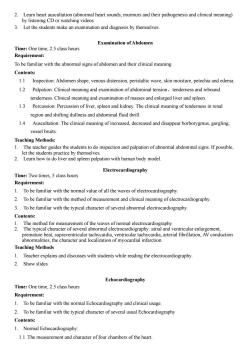
2. Learn heart auscultation(abnormal heart sounds,murmurs and their pathogenesis and clinical meaning) by listening CD or watching videos. 3.Let the students make an examination and diagnosis by themselves. Examination ofAbdomen Time:One time.2.5 class hours Requirement: To be familiar with the abnormal signs of abdomen and their clinical meaning Contents: 1.1 Inspection:Abdomen shape,venous distension,peristaltic wave,skin moisture,petechia and edema. 1.2 Palpation:Clinical meaning and examination of abdominal tension,tenderness and rebound tenderness.Clinical meaning and examination of masses and enlarged liver and spleen. 1.3 Percussion:Percussion of liver,spleen and kidney.The clinical meaning of tenderness in renal region and shifting dullness and abdominal fluid thrill. 14 Auscultation:The clinical meaning of increased,decreased and disappear borborygmus,gurgling. vessel bruits. Teaching Methods: 1.The teacher guides the students to do inspection and palpation of abnormal abdominal signs.If possible, let the students practice by themselves. 2 Learn how to do liver and spleen palpation with human body model Electrocardiography Time:Two times,5 class hours Requirement: 1. To be familiar with the normal value of all the waves of electrocardiography 2.To be familiar with the method of measurement and clinical meaning of electrocardiography 3.To be familiar with the typical character of several abnormal electrocardiography Contents: 2 The method for The typical chara me ter of sev eral abnor mal elect rdio .hy:airial and ventricular cnlargement abnormalities the character and localization of mvocardial infarction Teaching Methods 1.Teacher explains and discusses with students while reading the electrocardiography 2.Show slides. Echocardiography Time:One time,2.5 class hours Requirement: 1. To be familiar with the normal Echocardiography and clinical usage. 2. Tobe familiar with the typical character of several usual Echocardiography Contents: Normal Echocardiography 1.1 The measurement and character of four chambers of the heart
2. Learn heart auscultation (abnormal heart sounds, murmurs and their pathogenesis and clinical meaning) by listening CD or watching videos. 3. Let the students make an examination and diagnosis by themselves. Examination of Abdomen Time: One time, 2.5 class hours Requirement: To be familiar with the abnormal signs of abdomen and their clinical meaning Contents: 1.1 Inspection: Abdomen shape, venous distension, peristaltic wave, skin moisture, petechia and edema. 1.2 Palpation: Clinical meaning and examination of abdominal tension、tenderness and rebound tenderness. Clinical meaning and examination of masses and enlarged liver and spleen. 1.3 Percussion: Percussion of liver, spleen and kidney. The clinical meaning of tenderness in renal region and shifting dullness and abdominal fluid thrill. 1.4 Auscultation: The clinical meaning of increased, decreased and disappear borborygmus, gurgling, vessel bruits. Teaching Methods: 1. The teacher guides the students to do inspection and palpation of abnormal abdominal signs. If possible, let the students practice by themselves. 2. Learn how to do liver and spleen palpation with human body model. Electrocardiography Time: Two times, 5 class hours Requirement: 1. To be familiar with the normal value of all the waves of electrocardiography. 2. To be familiar with the method of measurement and clinical meaning of electrocardiography. 3. To be familiar with the typical character of several abnormal electrocardiography. Contents: 1. The method for measurement of the waves of normal electrocardiography. 2. The typical character of several abnormal electrocardiography: atrial and ventricular enlargement, premature beat, supraventricular tachycardia, ventricular tachycardia, arterial fibrillation, AV conduction abnormalities, the character and localization of myocardial infarction. Teaching Methods 1. Teacher explains and discusses with students while reading the electrocardiography. 2. Show slides. Echocardiography Time: One time, 2.5 class hours Requirement: 1. To be familiar with the normal Echocardiography and clinical usage. 2. To be familiar with the typical character of several usual Echocardiography Contents: 1. Normal Echocardiography: 1.1 The measurement and character of four chambers of the heart
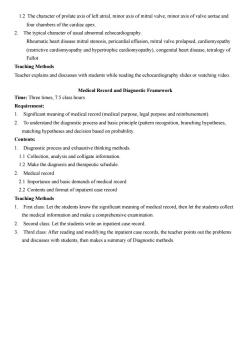
1.2 The character of prolate axis of f atrial,minor axis of mitral valve,minor axis of valve aortae and four chambers of the cardiac apex. 2.The typical character of usual abnormal echocardiography. Rheumatic heart disease mitral stenosis,pericardial effusion,mitral valve prolapsed,cardiomyopathy (restrictive cardiomyopathy and hypertrophic cardiomyopathy),congenital heart disease,tetralogy of Fallot Teaching Methods Teacher explains and discusses with students while reading the echocardiography slides or watching video. Medical Record and Diagnostic Framework Time:Three times,7.5 class hours Requirement: 1.Significant meaning of medical record(medical purpose,legal purpose and reimbursement). 2.To understand the diagnostic process and basic principle(pattern recognition,branching hypotheses, matching hypotheses and decision based on probability Contents: 1.Diagnostic process and exhaustive thinking methods. 1.1 Collection,analysis and colligate information. 1.2 Make the diagnosis and therapeutic schedule 2.Medical record 2.1 Importance and basic demands of medical record 2.2 Contents and format of inpatient case record Teaching Methods 1.First class:Let the students know the significant meaning of medical record,then let the students collect the medical information and make a comprehensive examination 2.Second class:Let the students write an inpatient case record. 3.Third class:After reading and modifying the inpatient case records,the teacher points out the problems and discusses with students,then makes a summary of Diagnostic methods
1.2 The character of prolate axis of left atrial, minor axis of mitral valve, minor axis of valve aortae and four chambers of the cardiac apex. 2. The typical character of usual abnormal echocardiography. Rheumatic heart disease mitral stenosis, pericardial effusion, mitral valve prolapsed, cardiomyopathy (restrictive cardiomyopathy and hypertrophic cardiomyopathy), congenital heart disease, tetralogy of Fallot Teaching Methods Teacher explains and discusses with students while reading the echocardiography slides or watching video. Medical Record and Diagnostic Framework Time: Three times, 7.5 class hours Requirement: 1. Significant meaning of medical record (medical purpose, legal purpose and reimbursement). 2. To understand the diagnostic process and basic principle (pattern recognition, branching hypotheses, matching hypotheses and decision based on probability. Contents: 1. Diagnostic process and exhaustive thinking methods. 1.1 Collection, analysis and colligate information. 1.2 Make the diagnosis and therapeutic schedule. 2. Medical record 2.1 Importance and basic demands of medical record 2.2 Contents and format of inpatient case record Teaching Methods 1. First class: Let the students know the significant meaning of medical record, then let the students collect the medical information and make a comprehensive examination. 2. Second class: Let the students write an inpatient case record. 3. Third class: After reading and modifying the inpatient case records, the teacher points out the problems and discusses with students, then makes a summary of Diagnostic methods
按次数下载不扣除下载券;
注册用户24小时内重复下载只扣除一次;
顺序:VIP每日次数-->可用次数-->下载券;
- 《诊断学》课程作业习题(英文,无答案).doc
- 《诊断学》课程作业习题(中文,部分含答案).doc
- 《诊断学》课程教学大纲(中英文双语).doc
- 重庆医科大学:《妇产科学》课程教学资源(PPT课件)29 计划生育.ppt
- 重庆医科大学:《妇产科学》课程教学资源(PPT课件)27 子宫内膜异位症.ppt
- 重庆医科大学:《妇产科学》课程教学资源(PPT课件)26 围绝经期综合征.ppt
- 重庆医科大学:《妇产科学》课程教学资源(PPT课件)25 闭经.ppt
- 重庆医科大学:《妇产科学》课程教学资源(PPT课件)24 功能失调性子宫出血.ppt
- 重庆医科大学:《妇产科学》课程教学资源(PPT课件)23 女性生殖器官损伤性疾病.ppt
- 重庆医科大学:《妇产科学》课程教学资源(PPT课件)22 妊娠滋养细胞疾病.ppt
- 重庆医科大学:《妇产科学》课程教学资源(PPT课件)21 卵巢肿瘤(ovarian tumor).ppt
- 重庆医科大学:《妇产科学》课程教学资源(PPT课件)20 子宫内膜癌.ppt
- 重庆医科大学:《妇产科学》课程教学资源(PPT课件)19 子宫肌瘤.ppt
- 重庆医科大学:《妇产科学》课程教学资源(PPT课件)17 女性生殖系统炎症.ppt
- 重庆医科大学:《妇产科学》课程教学资源(PPT课件)16 产后出血.ppt
- 重庆医科大学:《妇产科学》课程教学资源(PPT课件)15 胎儿窘迫.ppt
- 重庆医科大学:《妇产科学》课程教学资源(PPT课件)14 前置胎盘.ppt
- 重庆医科大学:《妇产科学》课程教学资源(PPT课件)12 妊娠合并急性病毒性肝炎.ppt
- 重庆医科大学:《妇产科学》课程教学资源(PPT课件)10 妊娠期肝内胆汁淤积症.ppt
- 重庆医科大学:《妇产科学》课程教学资源(PPT课件)09 妊娠合并糖尿病.ppt
- 《诊断学》课程考试试题(含参考答案).doc
- 石河子大学:《妇产科护理学》课程教学大纲 Nursing for Gynaecology and Obetetrics.pdf
- 石河子大学:《妇产科护理学》课程授课教案(负责人:张国琴).pdf
- 石河子大学:《妇产科护理学》课程教学课件(PPT讲稿)第十四章 月经失调病人的护理.ppt
- 石河子大学:《妇产科护理学》课程教学课件(PPT讲稿)第十六章 腹部手术病人的护理.ppt
- 石河子大学:《妇产科护理学》课程教学课件(PPT讲稿)第十三章 女性生殖系统炎症病人的护理.ppt
- 石河子大学:《妇产科护理学》课程教学课件(PPT讲稿)第十五章 妊娠滋养细胞疾病病人的护理.ppt
- 石河子大学:《妇产科护理学》课程教学课件(PPT讲稿)第九章 妊娠合并症妇女的护理.ppt
- 石河子大学:《妇产科护理学》课程教学课件(PPT讲稿)第十章 异常分娩妇女的护理.ppt
- 石河子大学:《妇产科护理学》课程教学课件(PPT讲稿)第十一章 分娩期并发症妇女的护理.ppt
- 石河子大学:《妇产科护理学》课程教学课件(PPT讲稿)第八章 妊娠期并发症妇女的护理.ppt
- 石河子大学:《妇产科护理学》课程教学课件(PPT讲稿)第五章 分娩期妇女的护理.ppt
- 石河子大学:《妇产科护理学》课程教学课件(PPT讲稿)第六章 产褥期管理.ppt
- 石河子大学:《妇产科护理学》课程教学课件(PPT讲稿)第一章 绪论 Obstetric and Gynecological Nursing.ppt
- 石河子大学:《妇产科护理学》课程教学课件(PPT讲稿)第二章 女性生殖系统解剖与生理.ppt
- 石河子大学:《妇产科护理学》课程教学课件(PPT讲稿)第四章 妊娠期妇女的护理.ppt
- 重庆医科大学:《实验诊断学》课程理论教学大纲(供五年制临床医学、儿科医学、预防医学、麻醉医学、影像医学专业本科使用).doc
- 重庆医科大学:《实验诊断学》课程实验教学大纲(供临床医学专业本科用).doc
- 重庆医科大学:《实验诊断学》课程教学资源(教案)第2讲 血液(下).doc
- 重庆医科大学:《实验诊断学》课程教学资源(教案)第6讲 肾功能.doc
